Introduction
As a new wave of networking technologies are rolled out, including 5G and fiber broadband, it has never been more important for telecommunications operators to innovate to rise up the value chain. This is especially true for Aggregation Routing and Transport as capacity continues to rise.
Availability of higher-speed access, resulting from global adoption of 5G and fiber broadband in particular, have enabled a new class of applications, including higher resolution video (4K, 8K, and even 12K), AR/VR (steadily growing), Tele-Medicine, etc.
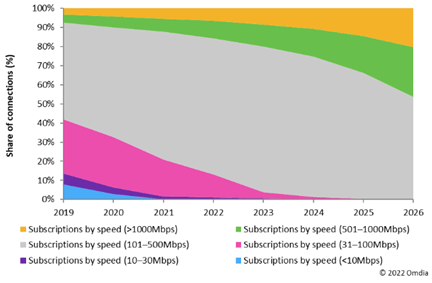
As user adoption for these services rapidly rises, Gbps Internet access is projected to double in the U.S. in 2022 (see Figure 1). Tremendous advancements in optical technologies are poised to address the demands, motivating a progression of Passive Optical Networking (PON) standards in ITU and IEEE, as depicted in Figure 2.
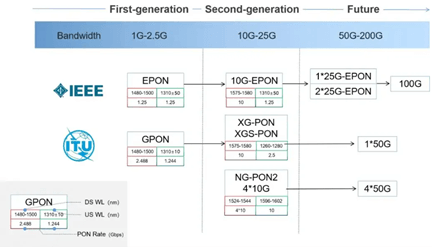
Even a global pandemic could not hinder the Global 5G rollout, with hundreds of live networks worldwide, and unprecedented wireless access speeds. 5G subscriptions already exceed 1 B subscribers worldwide (see Figure 3), with 4 times that projected by 2026.
Faster and faster access operators with a dizzying array of challenges.
Subscribers are only willing to pay a modest rate increase for higher-speed Internet or mobility access. How to accommodate dramatic rises in aggregation and transport capacity, while driving down costs remains elusive.
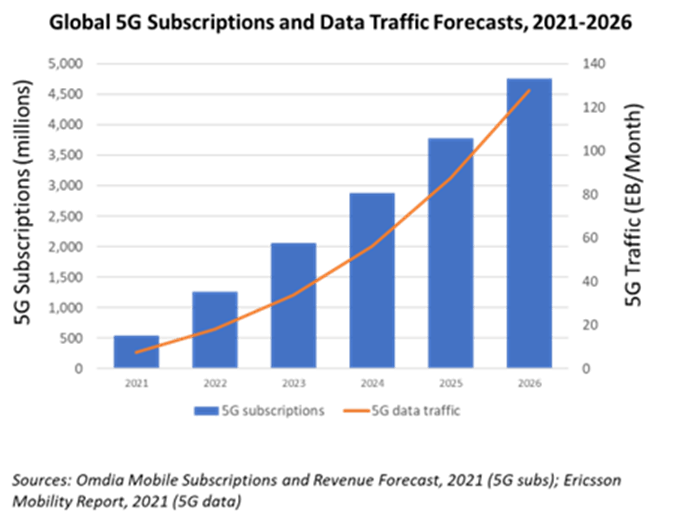
A New Approach is Needed
Achieving increased performance while simultaneously driving down costs necessitate innovation, a trend TM Forum refers to as ‘Telco to Techo’. Traditional networks, however, have been plagued by vendor lock-in, vertical integration, and operate on ‘Telco time’ and not ‘Cloud time’.
A new approach is needed. Operators are increasing turning to network disaggregation not only to dive new revenues and shift the cost curve, but also enable unprecedented innovation and openness (see Figure 4). In addition to achieving cost-effectively scalability, the substantial investment in the installed base must be protected, while future-proofing the network against tomorrow’s demands as well.
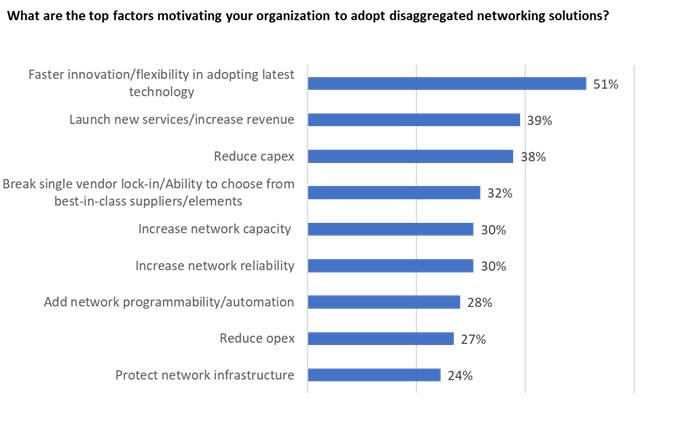
Source: Heavy Reading Open and Disaggregated Packet and Optical Networks, February 2021
Three other essential aspects are addressed below.
Openness
For decades, operators have been shackled by vendor lock-in by incumbent vendors, who have exacted a steep price on operators by dominating standards and technology roadmaps, severely limiting the ability to innovate.
Opening up the network places operators at the center of the networking ecosystem and not vendors whose interests may not be aligned. Standard interfaces, Multiple Sourcing Agreements (MSAs) Application Programming Interfaces (APIs) pave the way towards an inclusive, yet highly competitive ecosystem where vendors must innovate and constantly drive down costs to compete.
Openness is more than multi-vendor, but ultimately about operators regaining control of their networks, putting their interests first.
Cost-Effective Scalability
Cost-effective scalability requires a holistic vision that extends across each layer in the networking stack (see Table I). By disaggregating the network, operators may select the technologies, products, and vendors that best address the requirements for individual environments. For aggregation and transport, choice translates into high-performance at the lowest cost, and in turn, viability over the long-term, which requires constant innovation.
Table I – Scaling aggregation and transport require multiple technologies working in tandem
| Layer | Scale Targets | Technology (example) |
|---|---|---|
| Layer 3 | Routing Efficiency | Segment Routing |
| Layer 2 | Switching Bandwidth | Networking Silicon Advancements |
| Packet Optical | Transport Speeds Timing/Synchronization |
IPoDWDM pluggables IEEE 1588v2 ITU |
| Access | Access Speed | n* 10 EPON
4* 25G EPON 4*10G-PON2 4*50G . . . |
Cost-effective scalability encompasses:
- Improved routing efficiency, simplifies Aggregation and Provider Edge routing, which are essential building blocks in the high-capacity network-. Segment Routing (SR), is designed to significantly reduces routing processing, and increase the number of subscribers that may be supported.
- Increased Switching Bandwidth- expands network capacity, significantly boosting packet processing required to accommodate rising access speeds. Adoption of innovative silicon dramatically improves performance, while reducing power, cooling, and rack-space. For less-lower performance -intensive use cases, ability to use highlylower-end cost-effective silicon provides adequate capacity at substantially lower cost.
- Enhanced Transport, offers exponential improvements in capacity, fully exploiting the dramatic advancements in coherent optical technology. For instance, IPoDWDM, which is gaining traction, enables long-haul optics to be integrated directly in Provider Edge and Core Routers, eliminating intermediary hardware, and reducing TCO.
Pace of innovation
Architecting a network for the long-term requires an array of technologies in order to achieve the appropriate balance of performance, automation, integration, and cost. Consequently, it is imperative that operators have direct access to leading-edge technologies.
By breaking free from incumbent vendors, who may partner closely to develop new features only to offer them to competitors, true open networking enables operators to protect their innovation. The net result is faster time- to- market, a better fit with their environment and operational model, and of course reduction in costs.
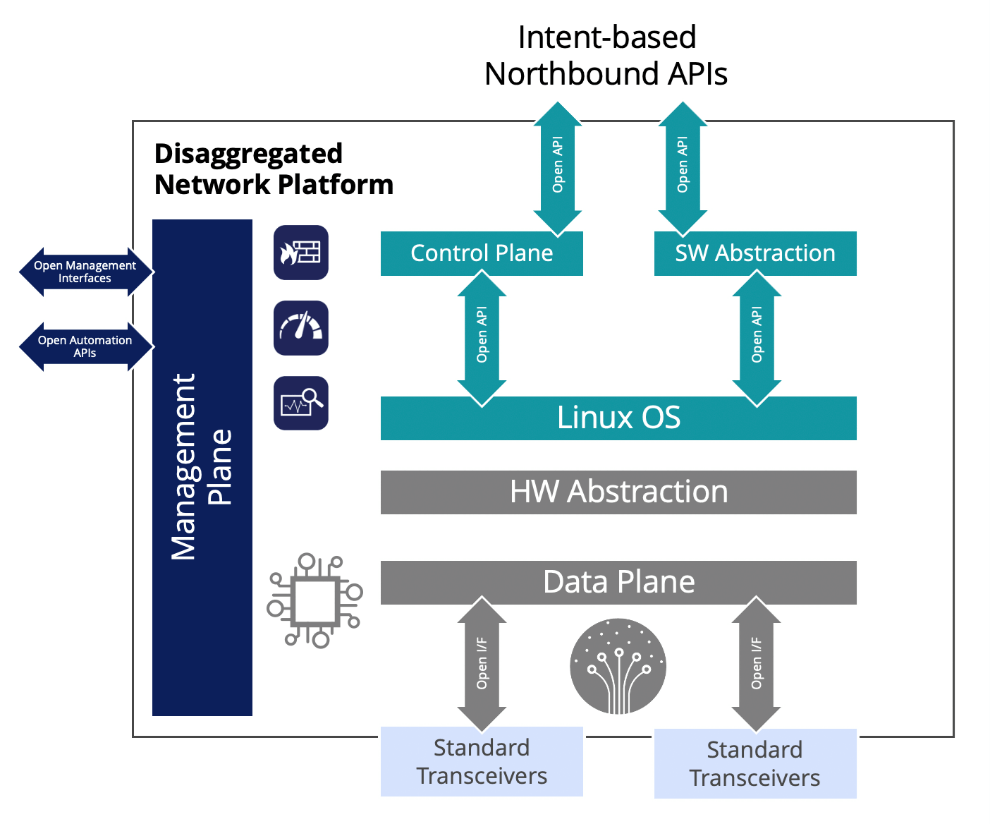
Open Network Software Platform
Evolving the aggregation and transport network to monumentally scale necessitates a revolutionary shift in mindset, yet an evolutionary enhancement to the network architecture.
By embracing network disaggregation, operators are afforded the opportunity to establish their own open ecosystem to regain control of technology roadmaps. This in turn rewards value delivery and innovation, lowering barriers for vendors to compete, while driving down costs.
At the core of the open ecosystem is the Network Software Platform (NSP) which must be meticulously architected to accommodate hardware platforms, switching silicon, advanced optics, security functions, etc., all from multiple vendors (see Figure 5). The NSP must also provide open APIs and management interfaces to facilitate integration into the operator’s environment.
Another critical requirement that separates Greenfield from Brownfield solution is a rich Control Plane that supports the features to seamlessly migrate from existing services and infrastructure, to satisfy today and tomorrow’s requirements. A carrier-grade management plane is expected by major operators, but not a given for Network Operating System vendors.
IP Infusion- the leader in open networking
IP Infusion is the world leader in open networking, and offers software, hardware, and solutions for a broad set of wireless and wireline use cases.
IP Infusion offers a broad portfolio of solutions and software built upon the most comprehensive Network Software Platform available. OcNOS has been widely deployed for cost-effective aggregation and transport for both wireless and fixed networks, and features a Control Plan on par with incumbent vendors to ensure seamless migration.
OcNOS has also been qualified by the TIP Open Optical Packet Transport (OOPT) Project Group, for a range of mobile network use cases. In addition, OcNOS was recently exercised at the O-RAN Alliance PlugFest held on two continents.
For more information about how to disaggregate and open up your network, visit us at:
IPInfusion.com
This blog is written by Shaji Nathan, IP Infusion’s Chief Technology Officer.

